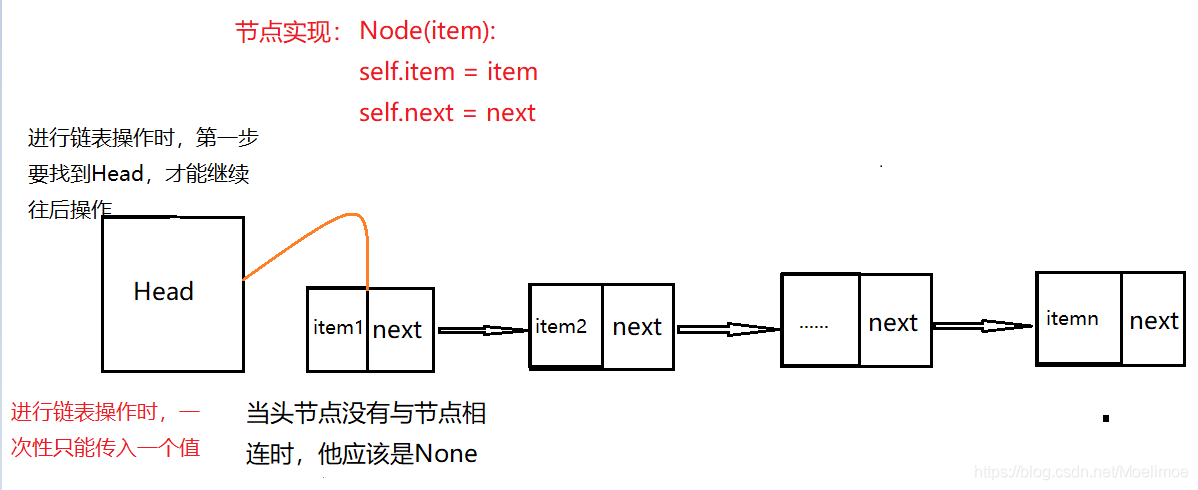Python3 实现单向链表
链表定义与简介
- 定义:链表与顺序表(Python中列表)性质相反,链表是物理单元上非顺序的、非连续的,在逻辑顺序上其数据元素是通过指针实现的,组成链表的每一个元素也可以叫做链表的节点,节点可以在运行时动态生成

单向链表中所有的元素也可以称之为节点,每个节点包含两个区域,如上图item区域称为数据域,next区域为指针域,单向链表中尾节点的判断只需判断该节点的指针(next)是否指向空即可。
链表(Linked list)与顺序表(Sequence list)的主要差异:
- 顺序表的内存地址是连续的,其数据元素有对应唯一的索引,搜索时非常方便,但进行元素插入时较麻烦,每次插入元素,其后所有元素都要移动一位。
- 而链表内存地址是非连续、非顺序的,逻辑顺序由指针实现,在插入元素时只需将指定位置的前一个元素的指针断开,并指向要插入的元素的节点,然后插入的元素指针再指向下一个节点即可,但是在查询元素时,需要从头结点开始一个一个遍历寻找。
由于链表不是必须按顺序存储,链表在插入的时候可以达到O(1)的复杂度,比线性表顺序表快得多,但是查找一个节点或者访问特定编号的节点则需要O(n)的时间,而线性表和顺序表相应的时间复杂度分别是O(logn)和O(1)。
定义单链表
# 定义节点
class Node:def __init__(self, item):self.item = itemself.next = None# 定义链表
class SingleLinkList:def __init__(self):self._head = Noneif __name__ == '__main__':# 创建链表link_list = SingleLinkList()# 创建结点node1 = Node(1)node2 = Node(2)# 将结点添加到链表link_list._head = node1# 将第一个结点的next指针指向下一结点node1.next = node2# 访问链表print("head", link_list._head) # 访问第一个结点数据print(link_list._head.item) # 访问第一个结点数据print(link_list._head.next.item) # 访问第二个结点数据
一个简单的链表,没有增删改查等功能,操作十分不便
接下来对其,进行一部分常用功能实现:
- 清空元素clear(),断开头结点的指针,长度为0
- 展示元素的值show_items()
- 获取元素get_value_by_index(),以偏移量获取元素的值,超出偏移量会报错IndexErorr,可以是负偏移
- 判断链表是否为空is_empty()
- 返回链表长度length()
- 在指定位置插入insert(),当超过实际长度,在最后插入;当为负数倒序选择插入,负数的绝对值大于实际长度则在最前面插入
- 在末尾追加元素append()
- 指定偏移量移除元素remove(),超过偏移量,抛出IndexErorr,可以使用负偏移
- 判断一个元素是否存在于链表is_exist(),存在返回True,否则返回False
- 返回元素的偏移indexOf()
代码实现
class Node:"""The nodes of single linked list"""def __init__(self, item):self.item = itemself.next = Noneclass SingleLinkedList:def __init__(self):"""Initialize the head and the length of single linked list"""self.head = Nonedef clear(self):"""CLear a linked list"""self.head = Nonedef show_items(self):"""Show all the elements of linked list"""if self.is_empty():return Nonecur = self.headwhile cur.next:yield cur.itemcur = cur.nextyield cur.itemdef get_value_by_index(self, index):"""Get a value by index"""node = self.headindex = self.length()+index if index < 0 else indexif index < 0:raise IndexError('index out of range')try:for i in range(index):node = node.nextreturn node.itemexcept AttributeError as e:raise IndexError('index out of range')def is_empty(self):"""Judge if a linked list is empty"""return self.head is Nonedef length(self):"""Return the elements number of a linked list"""cur = self.headif not cur:return 0count = 1while cur.next:count += 1cur = cur.nextreturn countdef insert(self, index, item):"""Insert an element before the given index of a node"""node = Node(item)length = self.length()# Empty list, append directlyif not self.head:self.append(item)if index < 0 and (index + length) >= 0:index += length# index>0if index > 0:cur = self.headwhile cur.next:if index <= 1:breakcur = cur.nextindex -= 1node.next = cur.nextcur.next = nodeelif index == 0 or index + length < 0:temp = self.headnode.next = tempself.head = nodedef append(self, item):"""Append elements to the end of a linked list"""node = Node(item)if self.is_empty():self.head = nodeelse:cur = self.headwhile cur.next:cur = cur.nextcur.next = nodedef remove(self, index):"""Remove an element by index"""if not -self.length() - 1 < index < self.length():raise IndexError('remove index out of range')if index < 0:index += self.length()print(f"index", index)if index == 0:print("Get into ")self.head = self.head.nextelse:cur = self.headpre = curwhile index > 0:pre = curcur = cur.nextindex -= 1pre.next = cur.nextdef is_exist(self, item):"""Judge if an element in linked-list"""return item in self.show_items()def indexOf(self, item):"""Return a given item's index where is the first appearance in the list"""return list(self.show_items()).index(item)
验证功能
if __name__ == '__main__':SLL = SingleLinkedList()print(f"If the linked list is empty?: {SLL.is_empty()}")# Append elements to the endfor i in range(5):SLL.append(i)print(f"Show all items:{list(SLL.show_items())}")print(f"The length of {SLL.__class__.__name__}: {SLL.length()}")# _index>0_index, _item = 9, 11SLL.insert(_index, _item)print(f"Insert {_item} before linked list[{_index}]: {list(SLL.show_items())}")# _index=0_index, _item = 0, 22SLL.insert(_index, _item)print(f"Insert {_item} before linked list[{_index}]: {list(SLL.show_items())}")# _index<0 and length+_index>0_index, _item = -3, 33SLL.insert(_index, _item)print(f"Insert {_item} before linked list[{_index}]: {list(SLL.show_items())}")# _index<0 and length+_index<0_index, _item = -21, 44SLL.insert(_index, _item)print(f"Insert {_item} before linked list[{_index}]: {list(SLL.show_items())}")_index = -5SLL.remove(_index)print(f"Remove an element by index[{_index}]: {list(SLL.show_items())}")# Get a value by index, if index out of range, throw a IndexError_index = 3print(f"Get a value by index[{_index}], its value: {SLL.get_value_by_index(3)}")_item = 44print(f"If item:[{_item}] in linked list {SLL.__class__.__name__}? {SLL.is_exist(_item)} ")# CLear a linked listprint(f"The linked list has been cleared: {SLL.__class__.__name__}: {SLL.clear()}")print(f"The length of {SLL.__class__.__name__}: {SLL.length()}")
结果
If the linked list is empty?: True
Show all items:[0, 1, 2, 3, 4]
The length of SingleLinkedList: 5
Insert 11 before linked list[9]: [0, 1, 2, 3, 4, 11]
Insert 22 before linked list[0]: [22, 0, 1, 2, 3, 4, 11]
Insert 33 before linked list[-3]: [22, 0, 1, 2, 33, 3, 4, 11]
Insert 44 before linked list[-21]: [44, 22, 0, 1, 2, 33, 3, 4, 11]
Remove an element by index[-5]: [44, 22, 0, 1, 33, 3, 4, 11]
Get a value by index[3], its value: 1
If item:[44] in linked list SingleLinkedList? True
The linked list has been cleared: SingleLinkedList: None
The length of SingleLinkedList: 0

)















)

